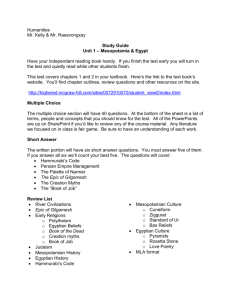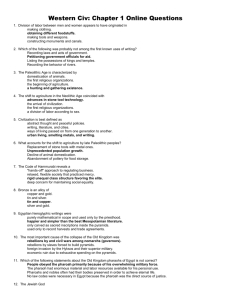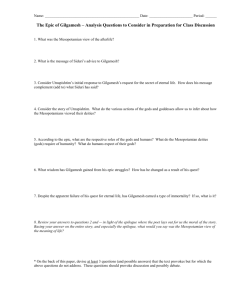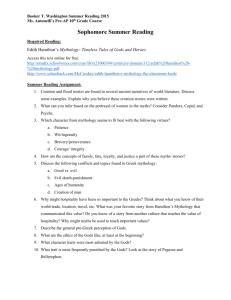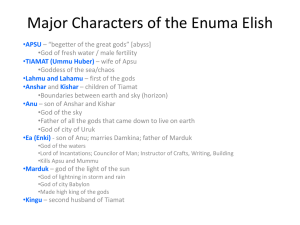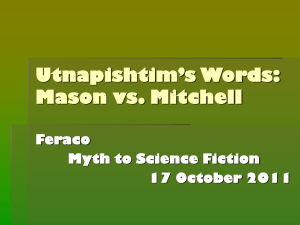Creation Myths of the Ancient World
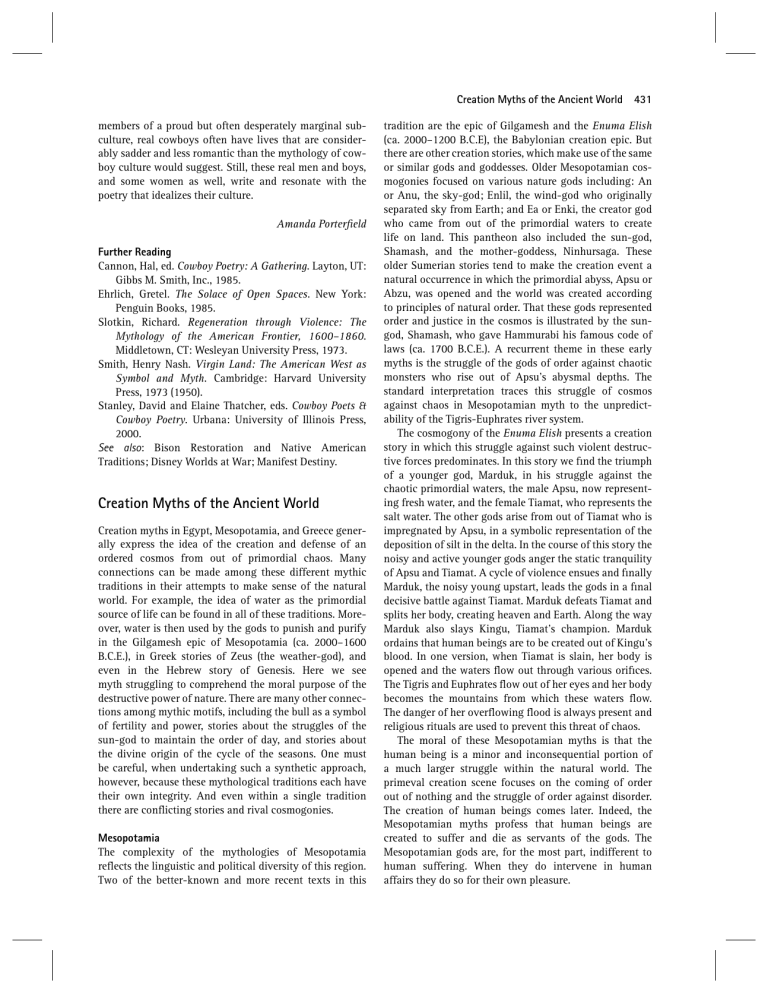
members of a proud but often desperately marginal subculture, real cowboys often have lives that are considerably sadder and less romantic than the mythology of cowboy culture would suggest. Still, these real men and boys, and some women as well, write and resonate with the poetry that idealizes their culture.
Amanda Porterfield
Further Reading
Cannon, Hal, ed. Cowboy Poetry: A Gathering . Layton, UT:
Gibbs M. Smith, Inc., 1985.
Ehrlich, Gretel. The Solace of Open Spaces . New York:
Penguin Books, 1985.
Slotkin, Richard. Regeneration through Violence: The
Mythology of the American Frontier, 1600–1860 .
Middletown, CT: Wesleyan University Press, 1973.
Smith, Henry Nash. Virgin Land: The American West as
Symbol and Myth . Cambridge: Harvard University
Press, 1973 (1950).
Stanley, David and Elaine Thatcher, eds. Cowboy Poets &
Cowboy Poetry . Urbana: University of Illinois Press,
2000.
See also : Bison Restoration and Native American
Traditions; Disney Worlds at War; Manifest Destiny.
Creation Myths of the Ancient World
Creation myths in Egypt, Mesopotamia, and Greece generally express the idea of the creation and defense of an ordered cosmos from out of primordial chaos. Many connections can be made among these different mythic traditions in their attempts to make sense of the natural world. For example, the idea of water as the primordial source of life can be found in all of these traditions. Moreover, water is then used by the gods to punish and purify in the Gilgamesh epic of Mesopotamia (ca. 2000–1600
B.C.E.), in Greek stories of Zeus (the weather-god), and even in the Hebrew story of Genesis. Here we see myth struggling to comprehend the moral purpose of the destructive power of nature. There are many other connections among mythic motifs, including the bull as a symbol of fertility and power, stories about the struggles of the sun-god to maintain the order of day, and stories about the divine origin of the cycle of the seasons. One must be careful, when undertaking such a synthetic approach, however, because these mythological traditions each have their own integrity. And even within a single tradition there are conflicting stories and rival cosmogonies.
Mesopotamia
The complexity of the mythologies of Mesopotamia reflects the linguistic and political diversity of this region.
Two of the better-known and more recent texts in this
Creation Myths of the Ancient World 431 tradition are the epic of Gilgamesh and the Enuma Elish
(ca. 2000–1200 B.C.E), the Babylonian creation epic. But there are other creation stories, which make use of the same or similar gods and goddesses. Older Mesopotamian cosmogonies focused on various nature gods including: An or Anu, the sky-god; Enlil, the wind-god who originally separated sky from Earth; and Ea or Enki, the creator god who came from out of the primordial waters to create life on land. This pantheon also included the sun-god,
Shamash, and the mother-goddess, Ninhursaga. These older Sumerian stories tend to make the creation event a natural occurrence in which the primordial abyss, Apsu or
Abzu, was opened and the world was created according to principles of natural order. That these gods represented order and justice in the cosmos is illustrated by the sungod, Shamash, who gave Hammurabi his famous code of laws (ca. 1700 B.C.E.). A recurrent theme in these early myths is the struggle of the gods of order against chaotic monsters who rise out of Apsu’s abysmal depths. The standard interpretation traces this struggle of cosmos against chaos in Mesopotamian myth to the unpredictability of the Tigris-Euphrates river system.
The cosmogony of the Enuma Elish presents a creation story in which this struggle against such violent destructive forces predominates. In this story we find the triumph of a younger god, Marduk, in his struggle against the chaotic primordial waters, the male Apsu, now representing fresh water, and the female Tiamat, who represents the salt water. The other gods arise from out of Tiamat who is impregnated by Apsu, in a symbolic representation of the deposition of silt in the delta. In the course of this story the noisy and active younger gods anger the static tranquility of Apsu and Tiamat. A cycle of violence ensues and finally
Marduk, the noisy young upstart, leads the gods in a final decisive battle against Tiamat. Marduk defeats Tiamat and splits her body, creating heaven and Earth. Along the way
Marduk also slays Kingu, Tiamat’s champion. Marduk ordains that human beings are to be created out of Kingu’s blood. In one version, when Tiamat is slain, her body is opened and the waters flow out through various orifices.
The Tigris and Euphrates flow out of her eyes and her body becomes the mountains from which these waters flow.
The danger of her overflowing flood is always present and religious rituals are used to prevent this threat of chaos.
The moral of these Mesopotamian myths is that the human being is a minor and inconsequential portion of a much larger struggle within the natural world. The primeval creation scene focuses on the coming of order out of nothing and the struggle of order against disorder.
The creation of human beings comes later. Indeed, the
Mesopotamian myths profess that human beings are created to suffer and die as servants of the gods. The
Mesopotamian gods are, for the most part, indifferent to human suffering. When they do intervene in human affairs they do so for their own pleasure.
432 Creation Myths of the Ancient World
Certain natural themes are ubiquitous in the Mesopotamian myths. One of the most important of these themes is water. Life is said to have come from water and silt.
One can see here an obvious connection with the natural environment of Mesopotamia where flooding and silt deposition were pressing concerns of early agriculturalists. The importance of water recurs in the Gilgamesh epic with the story of the flood as told to Gilgamesh by the immortal one, Utnapishtim. The gods destroyed humanity by way of the flood because the raucous noise made by human beings on Earth was disturbing to their ears.
Gilgamesh himself struggles through and across waters to find the immortal one who then directs him to a medicine that can ensure youthful longevity. This medicinal plant is found under water and is later lost by Gilgamesh when a snake comes out of a well and steals it from him. In the Gilgamesh, water is the important element against which human beings must struggle. This struggle does not promise a happy ending, however, as the waters themselves seem to be poised against human success. Human interaction with nature is thus antagonistic.
Egypt
While humans struggled before indifferent gods to subdue nature in the Mesopotamian stories, in Egypt they were seen as allies of the gods in their struggle to maintain order before the forces of chaos. Unlike the precarious and dangerous cosmos of the Mesopotamian stories, the
Egyptian cosmogonies seem to hold out the hope for stability and immortality. The Egyptian idea of the primordial nothingness was personified as Nun, waters which are inert and featureless. These waters are not like angry
Mesopotamian Tiamat. For the Egyptian, the cycle of time was stable, as represented by the movement of the sun across the sky and the regular cycle of the flooding
Nile. There was a promise of stability and permanence, even though there were dangers and monsters to be combated.
The Egyptian creation stories begin when Atum or Re, the first god, comes into existence. His appearance occurs in the same way that a hill might be revealed by the receding floodwaters of the Nile. This naturalistic metaphor has two important aspects for Egyptian mythology. First,
Egyptians tried to locate the point of Atum’s appearance at some definite geographical high point, which was then sanctified as a center of religious or political power.
Indeed, as the Egyptian tradition developed in different cultural centers (Heliopolis, Memphis, or Hermopolis, for example) the geographical location of this holy ground also shifted. Second, it connects the creation myth with the seasonal fluctuation of the Nile and so locates the
Egyptian mythology within the natural world. This seasonal ebb and flow, the concealing and revealing of land, may also have been the basis of Egyptian ideas about reincarnation, as seen in the myth of Osiris. In general, the
Egyptian cosmogony appealed to certain basic facts of
Egyptian climate and geography.
Other naturalistic elements occur in the Egyptian mythos, including the idea of the generation of the world from a primordial act of divine masturbation or expectoration, as Atum brought the world into existence from out of himself. This idea develops in a more intellectual direction, with connections to the Hebrew creation story, in which the creator god of the Memphis theogony, Ptah, speaks the word into existence. There is also a parallel story featuring the spontaneous generation of frogs and snake from out of the mud left by the receding floodwaters. This naturalistic theme was taken up in earnest by the cosmogony of Hermopolis, which was a city located midway between Thebes and Memphis. In the Hermopolitan cosmogony the cosmic egg either laid by a cackling goose, an ibis, or simply left by the receding waters.
Within this egg was the sun-god, Re, who then created the rest of the world. Finally, there were stories about the appearance of the divine flower, the lotus, growing out of the sacred lake at Hermopolis. This flower was again identified with the sun god. Other significant natural themes can be found in the animal imagery of these myths. The god Horus was connected with the falcon, which was connected with the sun, the falcon’s eye in the sky. In addition, the sun god was connected with the bull as a symbol of fertility and strength and the cow as a symbol of generation and motherhood.
These naturalistic themes in the Egyptian cosmogony make sense within the geographical context of the Nile system. The cyclical floods of the river, the repetition of cycles and seasons in the natural world showed the
Egyptians a concrete example of creation on a yearly basis. Creation occurred in the appearance of land, of the sun, the cycles of the moon, in the genesis of amphibian life, of eggs, and in the birth of the lotus from out of the nothing that was the primordial water of the river and of
Nun. The Egyptian concern with immortality and rebirth, its connection with a stable natural world, its worship of the sun-god, and its cult of the pharaoh (who was in some stories the reincarnation of Osiris and thus a descendent of
Re) – all of this is connected with the geographical context and its tendency to support these naturalistic explanations for the existence of the world. This natural order was based upon divine order or justice, which was called ma’at . This order required human support in the form of rituals and sacrifices because there were threats to order found in the coming of night, the waning of the moon, eclipses, and other natural disturbances to the rule of Re.
These disordered elements were personified in Apophis, the evil god who disrupted ma’at with its opposite, isfet – disorder or injustice. The cosmic struggle between Re and
Apophis, between light and dark, seen on a daily basis in the progress of the sun, found its ultimate significance in the cycle of birth and death that permeates the natural
world. Individual humans must support the cosmic order of nature, ma’at , so that they will be able to accompany
Osiris in pursuit of immortality.
Greece and Rome
In the Greek and Roman myths, as in Egypt and Mesopotamia, we find the creation of order, cosmos, out of chaos.
Our sources for Greek cosmogony include Homer, Hesiod, the Greek tragic poets, and later Roman poets such as Ovid
(spanning a time frame from the eighth century B.C.E to the first century). In the Greco-Roman mythos, Earth and
Heaven, Gaia and Uranos, are born from out of Chaos, the primordial undifferentiated abyss. We also see water as the primordial element, personified as Ocean, who surrounds the cosmos. Like the Mesopotamian myths, the Greek myths told of generations of gods struggling against one another. These generational struggles culminate in the battle of Zeus (the Roman Jupiter) against his father, the
Titan Cronus (Saturn). Eventually the Olympian gods became supreme under the leadership of Zeus. Zeus then led the battle against those monstrous offspring of Earth who represented disorder. Once Zeus was triumphant, struggle became understood as a struggle among the
Olympian gods. As in other mythic traditions, each Greek god was associated with some natural feature or power.
The struggle among these gods was thus used to explain natural phenomena such as earthquakes and storms, the rising and setting of the sun, etc. One of the more important of these stories, which figured in the mysteries of Eleusis, was the story of Demeter and Persephone.
Persephone was the daughter of Demeter, the goddess of grain and growing crops. Persephone was seized by Hades and carried to the underworld. In her agony over her lost daughter, Demeter stopped plants from growing until Zeus persuaded Hades to release Persephone. This story, which has obvious connections with the Egyptian stories of death and rebirth, explains the origin of the cycle of the seasons in terms of a struggle among the gods.
The Titan Prometheus created human beings and animals. Prometheus’ scatter-brained brother, Epimetheus, who assisted in the creation, botched the job somewhat by giving animals all sorts of physical advantages over humans. Prometheus remedied this by giving human beings the use of fire and other crafts. Another creation story, one taken up by Plato in the Republic , finds the gods experimenting with different metals, beginning with gold and ending up with iron. The current race of men is supposed to be descended from the iron race, at the degenerate end of the historical scheme. In these stories we discover the Greek view of the relation between gods and human beings. The gods have no real concern for the human except to the extent that humans maintain rituals for them and make sacrifices to them. Indeed, in one story, similar to the story in Gilgamesh and in the Hebrew bible,
Zeus supposedly floods the Earth to kill off the wicked iron
Creation Myths of the Ancient World 433 men, leaving, finally, only a degenerate race of men made from stone. These stories of degeneration seem to indicate the Greek awareness of the presence of ancient traditions left over from the Minoan and Cretan civilizations, whose culture was contemporary with that of the ancient
Egyptians and Mesopotamians. The point here is that the
Greeks possessed a healthy respect for the destructive power of the gods and the destructive potential of their natural powers. Odysseus, for example, was punished by
Poseidon for blinding Poseidon’s son, the Cyclops. As the god of the sea, Poseidon then buffeted Odysseus with storms and prevented him from returning home. Such stories were important for a people who lived and traded on the shores of the Mediterranean, subject to the whims of weather and sea.
Finally, in the literary development of the Greek and
Roman mythos, in the Latin poet Ovid’s Metamorphoses , we find the creative application of myth as explanation for a variety of natural phenomena. Ovid tells of various ways in which the gods meddle in human affairs for their own pleasure. He also tells us how certain plants and animals became the way they are by way of various metamorphoses of humans and gods. Here we find stories of natural transformations, which have become standard parts of Western culture: the stories of Narcissus and Echo,
Io and Europa. In this magical atmosphere, Ovid shows a syncretic tendency, using images and appealing to gods, which were part of foreign traditions, including the gods of Egypt.
The moral of the Greek tradition is thus similar to that of the Mesopotamian and Egyptian traditions. The natural world is created full of spiritual energies and divine beings. Human beings must be careful not to offend these natural deities and disrupt the order of the cosmos. And finally, the features of the natural landscape itself can be explained by way of divine conflict.
Andrew Fiala
Further Reading
Brandon, S.G.F. Creation Legends of the Ancient Near East .
London: Hodder & Stoughton, 1963.
Clifford, Richard J. Creation Accounts in the Ancient Near
East and in the Bible . Washington D.C.: The Catholic
Biblical Association of America, 1994.
Cohn, Norman. Cosmos, Chaos, and the World to Come .
New Haven: Yale University Press, 2001.
Frankfort, Henri. Kingship and the Gods . Chicago: University of Chicago Press, 1978.
Hamilton, Edith. Mythology . Boston: Little, Brown, and
Co., 1942.
Hughes, J. Donald. Ecology in Ancient Civilizations .
Albuquerque: University of New Mexico Press, 1975.
See also : Creation Story in the Hebrew Bible; Creation’s
Fate in the New Testament; Egypt – Ancient; Greco-Roman
434 Creation Story in the Hebrew Bible
World; Greece – Classical; Mesopotamia – Ancient to 2000
B.C.E.; Ovid’s Metamorphoses; Roman Religion and
Empire.
Creation Story in the Hebrew Bible
The Hebrew Bible preserves two contrary stories of God’s relation to nature and humans’ place within it, with little editorial attempt to harmonize the stories.
Genesis’ first creation account opens with God wrestling chaotic waters in utter darkness, the stormy conflict seemingly without beginning. God creates by pushing chaotic waters behind the barriers of firmament and Earth
(Gen. 1:6, 9). Water is pushed to the periphery of this story, a constant threat to creation if the water ever broke through its limits (Gen. 7:11–12; Ps. 46:1–3). The story’s closing mandate exhorts humankind to mimic the divine repression of chaos in order to live within this creation, and life is lived under threat (Gen. 1:28).
Water remains a continual danger to God’s chosen people, threatening God’s plan for his people’s survival at key points. Mass drowning during the flood makes the command to multiply and fill the Earth difficult (Gen. 9:1).
Called out of Egypt, Israelites pause before the sea in terror, wishing to return, but God dries up the sea so that they can proceed (Ex. 14:16). God repeats this at the river
Jordan so Israelites can cross into the Promised Land on dry ground (Josh. 3:16–17). But God may have driven water too far from the land promised to Abraham, as its frequent famines attest (Gen. 12:10; 26:1; Ruth 1:1).
Water is not the only natural threat to creature and
Creator. Israelite religious reformers hack and hew
Asherim – wooden pillars or trees at sacred sites that represent the goddess Asherah – to purify the cult (Ex. 34:13;
Deut. 7:5; 12:3; Jer. 2:26–27). God may consider living trees a personal threat to Israel (Ezek. 20:46–47; Isa.
10:33–34; Jer. 7:20). And wilderness becomes hostile to human existence as well (Gen. 21:15–16; Ex. 23:28–30;
Joshua 5:6).
Genesis’ second creation story gives a contrary view.
The story opens with creation thirsting for water to realize its potential (Gen. 2:4–5). God allies with rain, mixing with soil to make mud, into which he breathes divine breath. From this tripartite mix human farmers are pulled to till the land as well as animals to alleviate human loneliness (Gen. 2:5). God mandates a vegetarian diet that protects this sibling relationship (Gen. 2:16–17, also 1:29–30).
When humans transgress divine limits, this harmony turns adversarial and humans, animals, soil and water are estranged (Gen. 3:15–19). The hope of this story cycle is to a future return to this original harmony of God, soil, water and creature.
Water is key to bringing exiled Jews back to a verdant
Promised Land. God recasts the hostile desert landscape recreating it with springs, rivers and trees so that his people can freely eat and quench their thirst on their homeward journey (Is. 41:17–20; Ezek. 34).
Aspects of divinity are present in trees like the Tree of Life and the Temple Tree (Gen. 3:22; Ezek. 31; Isa.
55:12–13). God’s essential connection to trees compels
Abraham to camp at the groves of sacred trees at Beersheba, Shechem and Hebron so as not to miss divine encounters. Ezekiel envisions God as a sacred tree with water springing from his base (Ezek. 34:25–30; 41:15–26;
47:1–12). Israel also is like a tree according to God (Jer.
11:16, 19; 17:7–8; Hos. 9:10).
God’s presence at Mount Sinai is so strong that Moses must bring the people there to meet him (Ex. 19). Moses and Elijah venture into caves in Mount Sinai and experience intense personal encounters with God (Ex. 33:18–33;
1 Kings 19:8–13). Later God’s presence is integral to
Mount Zion in Jerusalem (Ps. 48:1–2, 12–14; 132:13).
Jacob, after visions of divinities shuttling between heaven and Earth, calls the mountain of Bethel a gate of heaven (Gen. 28:17). The wilderness is a place of divine restoration for Moses and Elijah (Ex. 3–4; 1 Kings 19:1–9).
God so pervades the natural world that ancient Israel’s legal and wisdom traditions assert that God’s will and character are evident in natural phenomena, as well as in animal and human behavior. The law consecrates human and animal life equally before God (Ex. 22:29–30; 23:5).
Animals suffer their domesticity, fulfilling their potential far from human habitation (Job 39:5–30).
The history of the covenant, the most legal of the
Bible’s formal agreements, begins with God making a promise to Noah and every living creature as equals (Gen.
9:9–12). That history ends on the Day of the Lord when
God will reestablish a covenant between all life, human and animal (Hos. 2:18–19, Joel 1:14–20). In Hosea’s vision
God establishes his final covenant by banishing violence to reconcile species (Hos. 2:20–23).
Within this creation story prophets cannot imagine the restoration of the people of God without a concurrent restoration of animals and nature back to their beginnings. In the words of Isaiah, “The Earth lies polluted under its inhabitants; for they have transgressed the laws, violated the statutes, broken the everlasting covenant.
Therefore a curse devours the Earth, and its inhabitants suffer for their guilt” (Isa. 24:5–6).
Human vigilance keeping nature’s chaotic elements in check is never relaxed in the worldview of the first story.
Reestablished harmony between humans, animals and land is the future hope of the second story. Although the two creation stories set out contrary roles for nature, the natural world in both is a medium of divine revelation and instruction – a role as significant as any historical event.
Matt Wiebe
